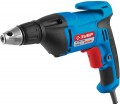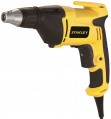Power consumption
The total power consumed by a mains-powered electric tool (see "Power Source"). It is considered the main criterion for assessing the overall capabilities of a particular model: more power allows you to achieve more speed and/or torque. However a more correct parameter for such an assessment is useful (working) power, but it is far from always indicated, and tools of the same type with similar power consumption usually do not differ much in terms of working power. In addition, data on power consumption also allows you to estimate the load on the power grid or other power source; in some cases this is unnecessary.
As for specific figures, for different types of tools, the characteristic power values will be different. For example,
from 750 to 1000 W is considered a very solid indicator for a screwdriver, while for classic drills this is an average value, among such devices there are options even for
1.5 kW or more. Detailed recommendations on choosing a tool for this parameter can be found in special sources. We only note that it does not always make sense to chase the maximum values high power noticeably affects the dimensions, weight and price of the unit, despite the fact that it is far from always required.
Torque
Torque is the maximum force with which this model is capable of turning the working nozzle.
Higher torque gives more options, it allows you to cope with complex tasks such as drilling in hard materials, unscrewing stuck screws and nuts, etc. On the other hand, a lot of force requires corresponding power — and this, in turn, affects the dimensions , weight and cost of the tool itself, and also puts forward increased power requirements (mains power, battery capacity or pressure / compressor performance). And for some tasks, excessive torque is basically unacceptable, so for maximum versatility, it is desirable to have
torque control — and this affects the cost even more. And the more steps, the more optimally you can configure the tool to perform a particular type of work. So the general rule is this: when choosing, it is worth considering the specifics of the planned work, and not chasing the greatest working effort.
Detailed recommendations on choosing the optimal torque for different types of tools (see "Device") can be found in special sources. Here we note that it is of key importance primarily for screwdrivers, although it is also given for other types of tools. At the same time, in the “weakest” models, the maximum working force does not exceed 15 Nm, in the most powerful ones it is more than 150 Nm.
Weight
The total weight of the tool is usually the device itself, without attachments. For battery models (see "Power Source"), usually, the weight is indicated with a standard battery installed; for battery-powered models, the weight can be given both with and without batteries, but in this case this point is not particularly important.
Other things being equal, less weight simplifies work, increases accuracy of movement and allows you to use the tool for longer without tiring. However, note that high power and productivity inevitably increase the mass of the tool; and various tricks to reduce weight increase the price and can reduce reliability. In addition, in some cases, a massive design is more preferable. First of all, this applies to work with a large load — for example, drilling holes of large diameter, or making recesses with impact: a heavy tool is more stable, it is less prone to jerks and shifts due to uneven material, vibration of mechanisms, etc.
It is also worth noting that specific weight values are directly related to the type of tool (see "Device"). Screwdrivers are the lightest — in most of them this figure
does not exceed 500 g. Screwdrivers and drill drivers are more "heavy": their average weight is
1.1 – 1.5 kg, although there are many lighter (
0.6 – 1 kg) and heavier (
1.6 – 2 kg or more ) models. And clas
...sic drills and wrenches have the greatest weight: such a tool must be quite powerful, so for them 1.6 – 2 kg is an average, 2.1 – 2.5 kg is above average, and many units weigh more than 2, 5 kg.
